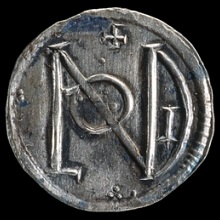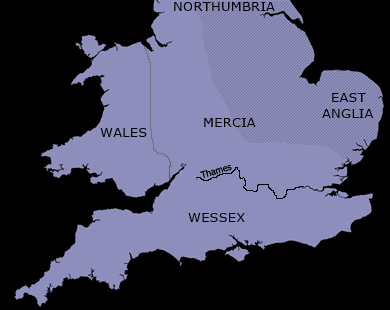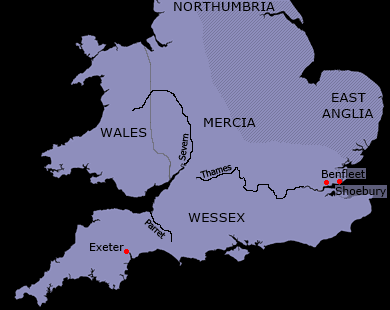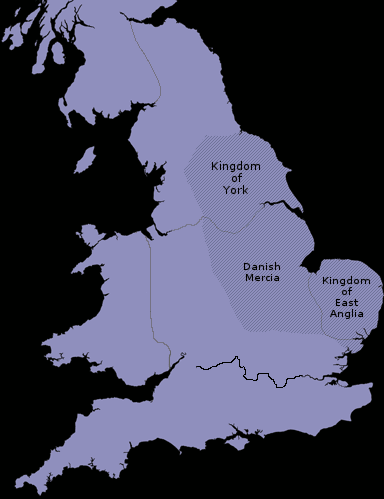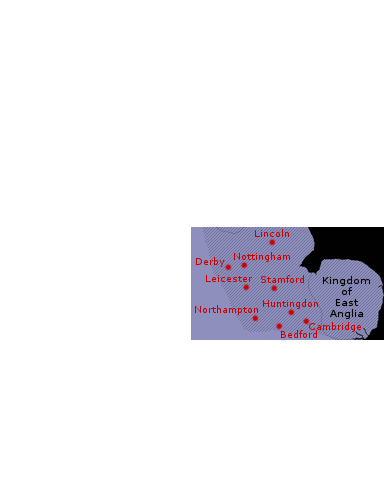WESSEX
Part Three[*]
King of the West Saxons
871 – 899 Alfred (‘the Great’)
Son of Æthelwulf.
Alfred (Ælfred) came to the throne “after Easter [15th April]” 871, following the death, from unknown causes, of his brother Æthelred – during a campaign against a ‘heathen army’ of Danes, i.e. Vikings, that had invaded Wessex in late-870, and had been reinforced by new arrivals from overseas shortly before Æthelred’s death.
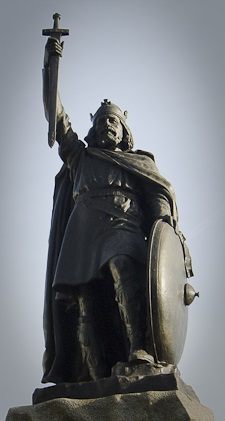
Alfred was the fourth son of Æthelwulf in succession to rule Wessex. His biographer, Asser, writes:
… Alfred, who had been up to that time, during the lifetime of his brothers, only of secondary rank, now, on the death of his brother, by God’s permission undertook the government of the whole kingdom, amid the acclamations of all the inhabitants of the kingdom; and indeed, if he had chosen, he might easily have done so with the general consent whilst his brother above named [i.e. Æthelred] was still alive, since in wisdom and every other good quality he surpassed all his brothers, and especially because he was a great warrior and victorious in nearly every battle. And when he had reigned a month almost against his will – for he did not think that he alone, without divine aid, could sustain the ferocity of the pagans, for even during his brothers’ lifetimes he had sustained great losses of many men – he fought a fierce battle with a few men, and on very unequal terms, against all the army of the pagans, at a hill called Wilton, on the south bank of the river Guilou [Wylye], from which river the whole of that district [Wiltshire] is named; and when both sides had been fighting fiercely and courageously for no small part of the day, the pagans, seeing the whole extent of the danger they were in, and no longer able to bear the attack of their enemies, turned their backs and fled. But, shame to say, they took advantage of their pursuers’ rashness [or possibly “fewness”], and, again rallying, gained the victory and held the battle-field. Let no one be surprised that the Christians had but a small number of men, for the Saxons [i.e. West Saxons] as a people had been all but worn out by 8 battles in this selfsame year against the pagans – in which 8 battles there died one pagan king, 9 earls, and innumerable troops of soldiers – not to speak of countless skirmishes both by day and by night, in which the oft-named King Alfred, and all the ealdormen of that people, with their men, and many of the king’s thegns, had been engaged in unwearied strife against the pagans.[*] How many thousand pagans fell in these numberless skirmishes God alone knows, over and above those who were slain in the 8 battles above mentioned. —
— In that same year [871] the Saxons made [i.e. bought] peace with the pagans, on condition that they should take their departure; and this they did. V ►Vita Alfredi §§42–43
In 874, the Danes drove out Burgred, king of Mercia, who was married to Alfred’s sister. (Burgred spent the rest of his life in Rome.) The Anglo-Saxon Chronicle says that they placed one Ceolwulf, “a foolish king’s thegn”, on the Mercian throne, to rule as their puppet. Ceolwulf’s charters, however, show him acting independently, with the consent of Mercian bishops and ealdormen, and, furthermore, he and Alfred collaborated in the production of coinage. At the time, therefore, Ceolwulf’s rule would appear to have been regarded as legitimate in both Mercia and Wessex.
In the autumn of 874, the Danes divided their forces. Part moved permanently to Northumbria, where they settled the area that became Yorkshire. The remainder – “a great army”, under three kings: Guthrum, Oscetel, and Anwend – spent the following year in Cambridge.
In the summer of 875, the Anglo-Saxon Chronicle notes that:
… King Alfred went out to sea with a ship-army [i.e. a naval force], and fought against the crews of 7 ships, and took one of them, and put to flight the others.
Towards the end of 875[*], the Danes, “a great army”, who had spent the year at Cambridge:
… stole away from the West Saxon army into Wareham [in Dorset]; —
— and after that [in 876] the king [i.e. Alfred] made peace with the army; —
— and they gave to him as hostages those who were most honoured next to their king in the army, and they swore oaths to him on the holy ring,[*] which they before would not do to any nation, that they would speedily depart from his kingdom;[*] and then under cover of that, they stole away from the [West Saxon] army by night – the mounted army [i.e. the Danes] to Exeter.[*]
The story continues in the next annal:
… the [mounted] army came to Exeter from Wareham; and the ship-army sailed west about, and then a great storm met them at sea, and there perished 120 ships at Swanage. And King Alfred with his army rode after the mounted army as far as Exeter, but could not overtake them before they were in the fortress, where they could not be come at.[*] And they there gave him as many hostages as he would have, and swore great oaths, and then held good peace. —
— And then in harvest-time [of 877] the army went into the Mercians’ land, and divided some of it, and gave some to Ceolwulf.
Æthelweard (IV, 3) says that the Danes:
… ravaged the kingdom of the Mercians, drove away the natives everywhere, and with one involved movement encamped in the town called Gloucester.
Just a few months later, however, at the beginning of 878, “in midwinter, after Twelfth Night” says the Chronicle:
… the army stole itself away to Chippenham, and over-rode the West Saxons’ land, and settled there, and drove a great part of the people over the sea, and most of the others they over-rode; and the people submitted to them, except King Alfred, and he, with a little band, fared with difficulty through woods and into moor-fastnesses.[*]
Asser (§52) notes that Chippenham, in northern Wiltshire, was: “a royal vill”, so it seems as though the Danes (it later becomes clear that this ‘army’ was led by King Guthrum) had hoped to capture Alfred there.[*]
Alfred had become a fugitive in his own kingdom. Asser takes up the story:
… King Alfred, with a few of his nobles, and certain soldiers and vassals, was leading in great tribulation an unquiet life among the woodlands and swamps of Somerset; —
— for he had nothing that he needed except what by frequent sallies he could forage openly or stealthily from the pagans or from the Christians who had submitted to the rule of the pagans.Vita Alfredi §53
Asser:
In that same year [878] the brother of Ivar and Halfdan,[*] with 23 ships, came, after many massacres of the Christians, from the region of Dyfed [south-west Wales], where he had wintered, and sailed to Devon, where with 1200 others he met with a miserable death, being slain, while committing his misdeeds, by the king’s thegns, before the fortress of Cynuit, in which many of the king’s thegns, with their followers, had shut themselves up for safety. The pagans, seeing that the fortress was unprepared and altogether unfortified, except that it merely had ramparts after our manner, determined not to assault it, because that place is rendered secure by its position on all sides except the eastern, as I myself have seen, but began to besiege it, thinking that those men would soon surrender from famine, thirst, and the blockade, since there is no water close to the fortress.[*] But the result did not fall out as they expected; for the Christians, before they began at all to suffer from such want, being inspired by Heaven, and judging it much better to gain either victory or death, sallied out suddenly upon the pagans at daybreak, and from the first cut them down in great numbers, slaying also their king, so that few escaped to their ships. —
— The same year [878], after Easter, King Alfred, with a few men, made a fortress in a place called Athelney, and from thence sallied with his vassals of Somerset to make frequent and unwearied assaults upon the pagans. —
— And again, the 7th week after Easter, he rode to Egbert’s Stone [unidentified], which is in the eastern part of Selwood Forest (in Latin Sylva Magna [Great Forest], and in Welsh Coit Maur). Here he was met by all the inhabitants of Somerset and Wiltshire, and all the inhabitants of Hampshire who had not sailed beyond the sea for fear of the pagans; —
— and when they saw the king restored alive, as it were, after such great tribulation, they were filled, as was meet, with immeasurable joy, and encamped there for one night. At daybreak of the following morning, the king struck his camp, and came to Æcglea, where he encamped for one night.[*]
The next morning at dawn he moved his standards to Edington [in Wiltshire], and there fought bravely and perseveringly by means of a close shield-wall against the whole army of the pagans, whom at length, with the divine help, he defeated with great slaughter, and, smiting the fugitives, pursued them as far as the fortress [probably Chippenham]. He carried off everything that he could find outside the fortress – men and horses and cattle, and the men he slew immediately – and boldly pitched his camp, with all his army, before the gates of the pagan fortress. And when he had remained there 14 days, the pagans, terrified by hunger, cold, fear, and last of all by despair, begged for peace, engaging to give the king as many named hostages as he pleased, and to receive none from him in return – in which manner they had never before made peace with any one. —
— When he had heard their embassy, the king, as is his wont, was moved with pity, and took from them as many named hostages as he wanted. When they had been received, the pagans swore, besides, that they would straightway leave his kingdom; and their king, Guthrum, promised to embrace Christianity, and receive baptism at King Alfred’s hands – all of which articles he and his men fulfilled as they had promised. For after 3 weeks Guthrum, king of the pagans, with 30 of the choicest men from his army, came to King Alfred at a place called Aller, near Athelney, and there King Alfred, receiving him as a son by adoption, raised him up from the holy font of baptism.[*] On the 8th day, at a royal vill named Wedmore, his chrism-loosing took place.[*] After his baptism he remained 12 nights with the king; and the king generously bestowed many and excellent gifts on him and all his men.Vita Alfredi §§54–56
In the autumn of 878 (therefore, s.a. 879 in the Anglo-Saxon Chronicle):
… the army [i.e. Guthrum’s army] went to Cirencester [in Mercian territory] from Chippenham, and sat there one year. And in that year a gang of Vikings assembled, and sat down at Fulham on the Thames.
A year later, i.e. in the autumn of 879:
… [Guthrum’s army] went from Cirencester to East Anglia, and occupied and divided the land. And in the same year the army, which had before sat down at Fulham, went over sea to Ghent in the land of the Franks …
Guthrum had taken the name Athelstan at his baptism. He ruled East Anglia, issuing coins under his Christian name.
In late-881 or 882 (s.a. 882):
… King Alfred went out to sea with ships, and fought against four ship-crews of Danish men, and took two of the ships, and the men were slain that were therein; and two ship-crews surrendered to him, and they were severely cut and wounded before they surrendered.[*]
No chronicler provides any relevant information, but, according to a charter (S345), Alfred campaigned in the vicinity of Epsom, Surrey, in 882.
Meanwhile, the Viking army that had sailed from Fulham in autumn 879 was plaguing the Franks. In 884 it was at Amiens. Towards the end of that year, as Asser records:
… the aforesaid army divided into two parts: one body of them went into East Francia, and the other, coming to Britain, entered Kent, where they besieged a city called in Saxon Rochester, situated on the east bank of the river Medway. The pagans at once erected a strong fortification in front of its gate; but they were unable to take the city, because the citizens defended themselves bravely until King Alfred came up to help them with a large army. Then the pagans abandoned their fortress and all the horses which they had brought with them out of Francia, and, leaving behind them in the fortress the greater part of their prisoners on the sudden arrival of the king, fled in haste to their ships. The Saxons immediately seized upon the prisoners and horses left by the pagans; and so the pagans, compelled by dire necessity, returned the same summer [i.e. 885] to Francia.Vita Alfredi §66
In fact, this last statement is not quite correct. The version of the Chronicle to which Asser had access clearly had a passage missing – as, indeed, do all the surviving Chronicle manuscripts – which Æthelweard (IV, 3) has, albeit in his tortured Latin, preserved. It appears that only some of this Viking army returned to the Continent. The remainder came to terms with Alfred, but proceeded to break their word, and twice raided south of the Thames. They were helped by “the foul people who then held East Anglia”, i.e. Guthrum’s people, and the combined forces set up a base at Benfleet in Essex. For unspecified reasons, there was a falling-out between the two factions, and at this point the remainder of the Viking army sailed for the Continent. Asser continues:
In that same year [i.e. in 885] Alfred, king of the Anglo-Saxons, shifted his fleet, full of fighting men, from Kent to East Anglia, for the sake of spoil.[*] No sooner had they arrived at the mouth of the river Stour than 13 ships of the pagans met them, prepared for battle. A fierce naval combat ensued, and the pagans were all slain; all the ships, with all their money, were taken. After this, while the victorious royal fleet was reposing, the pagans who occupied East Anglia assembled their ships from every quarter, met the same royal fleet at sea in the mouth of the same river, and, after a naval engagement, the pagans had the victory. …
In that same year also, the army of pagans which dwelt in East Anglia disgracefully broke the peace which they had concluded with King Alfred.Vita Alfredi §67 & §72
It will be recalled that previously, in “harvest-time” 877: “the army went into the Mercians’ land, and divided some of it, and gave some to Ceolwulf.” It would appear that, roughly speaking, the Danes colonized the eastern half of Mercia, leaving the west to English rule. Numismatic evidence tends to suggest that the Mercian town of London remained in English hands – that coins in the names of both Ceolwulf, the Viking appointed English king of Mercia, and Alfred were minted there, and that Alfred’s coins continued to be produced there after Ceolwulf’s rule ended. Ceolwulf disappears from history in 877, but he is assigned a reign of five years in a Mercian king-list from Worcester, by which token he ceased to rule in 879. His successor, the final name on the list, is Æthelred. When, however, this Æthelred eventually appears in the historical record – in a charter from Worcester dated 883 (S218) – he is ruling English Mercia not as a king, but as an ealdorman, with Alfred as his overlord. Æthelred, though, had greater status than an ordinary ealdorman. He is given various titles in different sources, even ‘king’ occasionally, but he is generally known by the description he receives in the, so-called, Mercian Register: ‘lord of the Mercians’. Around the mid to late 880s, Æthelred married Alfred’s daughter (his eldest child), Æthelflæd.[*] At any rate, according to some manuscripts of the Chronicle, it seems that in 883 London had been occupied by a Viking force:
… Pope Marinus [882–884] sent the lignum Domini [i.e. wood of Christ’s cross] to King Alfred. And in the same year Sigehelm and Athelstan conveyed to Rome the alms which King Alfred had vowed to send thither – and also to India, to St Thomas and to St Bartholemew – when they sat down against [i.e. besieged] the army at London;[*] and there, God be thanked, their prayer was very successful, after that vow.[*]
In 885 the Viking force from the Continent was active in the vicinity of the Thames estuary, and in the next year, 886, all manuscripts of the Chronicle report that: “King Alfred occupied Lundenburh [i.e. the fortified Roman city of London]”.[*] Asser (§83) says: “Alfred, king of the Anglo-Saxons, after the burning of towns and the massacre of people, honourably restored the city of London and made it habitable”.[*]
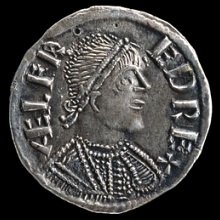
The Chronicle entry for 886 continues: “and all the English race turned to him [Alfred] that were not in the bondage of the Danish men; and he then committed the burh [of London] to the keeping of Ealdorman Æthelred.”
A ‘burh’ (from which the modern word ‘borough’) is simply a fortified site. It is evident that Alfred established a strategic network of burhs – some were adaptations of existing strongholds (as at London) and some were constructed from scratch – for the defence of his kingdom. A much-debated text, known as the ‘Burghal Hidage’, listing thirty-one burhs, and the resources allotted to maintain each, has survived.[*] The garrison of a burh was calculated on the basis of the length of its defensive wall – each ‘pole’ (5½ yards) of wall was allocated four men.
The Anglo-Saxon Chronicle notes, s.a. 887: “Ealdorman Æthelhelm conveyed the alms of the West Saxons and of King Alfred to Rome.” Asser (§86) adds that Æthelhelm was ealdorman of Wiltshire – this is the last occasion that Asser makes use of the Chronicle.[*] In 888: “Ealdorman Beocca conveyed the alms of the West Saxons and of King Alfred to Rome.” The next year, 889: “there was no journey to Rome, except that King Alfred sent two couriers with letters.” And in 890:
… Abbot Beornhelm conveyed the alms of the West Saxons and of King Alfred to Rome. And Guthrum, the Northern king, died, whose baptismal name was Athelstan; he was King Alfred’s godson, and he abode in East Anglia, and was the first [of the Danes] to settle that land.
The text of a treaty made between Alfred and Guthrum, in which the border between their territories is defined, has survived[*].
The Invasion of 892
In 892, a large Viking force, a “great army”, sailed across the Channel from Boulogne, in a fleet of 250 (or thereabouts) ships, “with horses and all”, and landed in the mouth of the river Limen (now the Rother):
The mouth is in the east of Kent, at the east end of the great wood which we call Andred [i.e. the Weald].[*] The wood is in length, from east to west, one hundred and twenty miles long, or longer, and thirty miles broad. The river, of which we before spoke, flows out from the weald. On the river they pulled up their ships as far as the weald, 4 miles from the outward mouth, and there stormed a work [i.e. a fortification]; inside that fastness sat a few peasant men, and it was half-made.[*]
This “great army” built a fortress at Appledore. Meanwhile, a smaller army, led by a Viking of some repute called Hæsten, had sailed, in 80 ships, from the Continent into the Thames estuary, and built a fortress at Milton Regis.[Map]
893 [*]
Alfred realized that these two newly arrived armies might get support from the Danes already living in England. Accordingly, he secured the word of the Northumbrian Danes and the East Anglian Danes – the East Anglians even gave 6 hostages – that they would not get involved. They promptly broke their word, however, and joined in the newcomers’ raiding activities. Alfred established a camp between the two fortresses – his patrols prevented any large scale Viking forays.
The account provided by the Chronicle is rather confusing,[*] but it was apparently at this stage that an accommodation was reached between Alfred and Hæsten. As a part of the settlement, Alfred became godfather of one of Hæsten’s sons, and Ealdorman Æthelred, lord of the Mercians, godfather of the other. Hæsten, though, was not acting in good faith. He and his men crossed the Thames, constructed a fortress at Benfleet in Essex,[Map] and commenced marauding: “he harried that part of his [Alfred’s] kingdom which Æthelred, his son’s godfather, had to defend”.
According to Æthelweard (IV,3), it was after Easter (Easter fell on the 8th of April in 893) that the large army managed to break-out from their fortress at Appledore – heading westwards through the Weald, using the dense undergrowth as cover – “and gradually wasted the adjacent provinces, that is Hampshire and Berkshire.” Their ships, meanwhile, had set sail for Essex. The Chronicle takes up the story:
They [the large army] had then taken great booty, and would convey it northwards over the Thames into Essex towards the ships. The [English] force —
— then rode in front of them, and fought against them at Farnham [in Surrey],[Map] and put the army to flight, and rescued the booty; and they [the Vikings] fled over the Thames without any ford; then up by the Colne to an island.
Æthelweard gives the name of the island: “Thorney”. It is probably to be identified with the hamlet of that name near Iver, Buckinghamshire.[Map]
The English forces besieged the Viking army on the island. After a time, however, the English troops had: “stayed their appointed time [i.e. completed their turn of duty] and consumed their provisions”. Alfred, with fresh troops, was on his way to relieve them, so they departed. The Vikings, though, were unable to turn this to advantage, and escape, since their (unnamed) king was wounded.
Meanwhile, the Danes of Northumbria and East Anglia:
… gathered some hundred ships, and went south about; and with some forty ships went north about, and besieged a work in Devonshire by the north sea [the Bristol Channel];[*] and those who went south about besieged Exeter.[Map]
As soon as the news reached Alfred, he and his main force headed for Exeter, whilst a small detachment, under Edward, carried on to Thorney.
According to Æthelweard, Edward was joined by Æthelred, lord of the Mercians – in fact, Æthelweard calls him “King Æthelred” – who brought reinforcements from London.[Map] A deal was negotiated. The Vikings agreed to leave Æthelred’s domain, and went from Thorney to join their ships at Mersea,[Map] an island off the Essex coast.[*]
Assuming Æthelweard is correct when he says, in his brisk version of events, that the Vikings from Thorney met their ships at Mersea, then they must have sailed south to join Hæsten’s army at Benfleet, since that is where they are next encountered in the long and convoluted account presented by the Anglo-Saxon Chronicle. It would appear that the English force from Thorney also travelled eastwards, and, having received reinforcements at London and “from the west”, they marched on Benfleet. At the time, Hæsten and his small army had “gone out harrying”, so only the “great army”, seemingly lately arrived from Mersea, was in residence. The English:
… put the army to flight, and stormed the work, and took all that was there within, both money and women and also children, and brought all to London-burh [i.e. the fortified Roman city of London]; and all the ships they either broke in pieces, or burned, or brought to London-burh, or to Rochester[*]…[Map]
Hæsten’s wife and two sons were captured and taken to Alfred. Alfred, however, released them because he had earlier stood as godfather to one of the boys, and Æthelred to the other.
The defeated army apparently regrouped and joined-up with Hæsten’s army:
… at Shoebury in Essex,[Map] and there wrought a work, [and] they then went both together up along the Thames, and a great increase came to them, both from the East Angles and the Northumbrians. They then went up along the Thames, until they reached the Severn, then up along the Severn.[*] Then Ealdorman Æthelred and Ealdorman Æthelhelm [of Wiltshire] and Ealdorman Æthelnoth [of Somerset], and the king’s thegns who were then at home in the works, gathered together from every burh east of the Parret, both west and east of Selwood, and also north of the Thames and west of the Severn, and also some part of the Welsh race. When they were all gathered together, they overtook the army from behind at Buttington on the bank of the Severn,[Map] and there besieged them on every side in a fastness.
During this whole period, Alfred was in Devon. The Chronicle makes no further mention of the Viking band who had besieged an unnamed burh on the Bristol Channel, but the group besieging Exeter had taken to their ships on Alfred’s arrival and were keeping him busy.
At Buttington [near Welshpool],[*] meanwhile, the Viking forces were pinned-down for “many weeks” in their riverside stronghold: “they were distressed for want of food, and had eaten a great part of their horses, and the others had died of hunger”. Eventually, they broke-out and fought a fierce battle against the English forces camped on the east side of the river. The English were victorious. Many Danes were killed; the survivors fled back to Essex.
The Chronicle reports:
When they came into Essex to their work [at Shoebury] and to their ships, the remnant gathered again a great army from the East Angles and from the Northumbrians, before winter, and committed their women and their ships and their money to the East Angles, and went at one stretch, by day and by night, until they arrived at a desolated city in Wirral, which is called Chester.[Map]
It is possible that Hæsten led this dash to the, apparently deserted, fortified Roman city of Chester, but he has now disappeared from the record. Whoever their leader was, by the time English forces caught up with them, the Danes were safely ensconced inside Chester’s walls, so:
… they besieged the work from outside for some two days, and took all the cattle that were outside there, and slew the men that they could intercept outside the work, and burned all the corn, and with their horses consumed the whole neighbourhood.
894
As a result of the English army’s scorched-earth policy, the Danes abandoned Chester. They crossed into Wales, where the Chronicle loses sight of them. An entry in the A-text of the Annales Cambriae, however, might suggest that they travelled the length of the country: “The Northmen came and laid waste Lloegr [England] and Brycheiniog and Gwent and Gwynllwg [all in the south eastern quarter of Wales].”
Later in the year, the Danes reappear on the English radar:
When they had again wended out of Wales with the booty which they had there taken, then they went over Northumbria and East Anglia, so that the [English] army could not reach them, until they came into the eastward part of Essex, to an island that is out in the sea, which is called Mersea.[Map] And when the [Viking] army that had besieged Exeter turned back homewards, they harried in Sussex near Chichester,[Map] and the townspeople put them to flight, and slew many hundreds of them, and took some of their ships. Then, in the same year, in early winter,[*] the Danish who sat in Mersea pulled [i.e. rowed] their ships up the Thames, and then up the Lea.[Map]
At a place on the Lea: “20 miles above London-burh”, i.e. in or near Hertford,[Map] the Danes built a fortress.[*]
895
The English appear to have tolerated the Danes’ presence on the Lea until the summer of 895, when a force, seemingly comprising “a great part” of the London garrison[*] and also some “other folk”, attacked their fortress. The English: “were there put to flight, and some four king’s thegns slain.” The immediate danger in Devon having passed, Alfred was free to take a personal interest in the situation:
… during the harvest, the king encamped in the neighbourhood of the burh [London] while they reaped their corn, so that the Danish could not deprive them of the crop. Then one day the king rode up along the river, and observed where the river might be obstructed so that they [the Danes] could not bring out their ships.
Work began – fortifications were being built on each side of the Lea. When the Danes realized their ships were going to be trapped, they decided to abandon them. Having sent their womenfolk to safety in East Anglia, they broke-out from their stronghold and made an overland dash to Bridgnorth, on the Severn,[Map] where they built another fortress. English forces had chased after them, but what they accomplished is not recorded. Meanwhile: “the men of London-burh fetched the ships, and all that they could not bring away they broke up, and those that were serviceable they brought into London-burh.”
896
The Danes, “the army”, spent the winter of 895/6 and spring 896 at Bridgnorth. There is no record of their activities.
In the summer of 896:
… the army went, some to East Anglia, some to Northumbria; and they who were moneyless got themselves ships and went south over sea to the Seine. Thanks be to God, the army had not utterly broken the English race; but they were much more broken, in those three years, by a pestilence of cattle and of men; most of all in that many of the best king’s thegns that were in the land died in those three years; of these, one was Swithwulf, bishop in Rochester, and Ceolmund, ealdorman in Kent, and Beorhtwulf, ealdorman in Essex, and Wulfred, ealdorman in Hampshire, and Ealhheard, bishop at Dorchester, and Eadwulf, king’s thegn in Sussex, and Beornwulf, town-reeve in Winchester, and Ecgwulf, king’s horse-thegn, and many also besides these, although I have named the most eminent.[*]
The remnants of the Viking armies, that had since their arrival in 892 rampaged across south-Humbrian England (and also Wales), dispersed in the summer of 896, but the south coast of Wessex continued to be harassed by pirates from Northumbria and East Anglia. The Anglo-Saxon Chronicle reports that Alfred ordered the construction of some new ships:
… which were full nigh twice as long as the others; some had 60 oars, some more; they were both swifter and steadier, and also higher than the others; they were shapen neither as the Frisian nor as the Danish, but as it seemed to himself that they might be most useful.
Alfred sent nine of his new ships in pursuit of six Viking ships that were raiding along the south coast between the Isle of Wight and Devonshire. Alfred’s ships trapped the Vikings in an estuary. Three of the Viking vessels were beached whilst their occupants were ashore. Alfred’s ships engaged the other three, capturing two at the river-mouth, and killing the occupants. The third ship, however, managed to escape (though all but five of the men aboard had been killed) because the large English ships had run aground. As the tide retreated, three of the English ships were left high and dry on the same side of the river as the beached Viking ships, whilst the rest were stranded on the other side. The Danes from the three Viking ships, attacked the three isolated English vessels. In the ensuing battle, Alfred’s forces, which comprised both Englishmen and Frisians,[*] lost 62 men, whilst 120 Danes were killed. The incoming tide floated the Viking ships first, allowing them to make their escape; however:
… they were then so wounded that they could not row past Sussex, but there the sea cast two of them on land, and the men were led to the king at Winchester, and he commanded them to be there hanged; and the men who were in the one ship [that didn’t get cast ashore] came to East Anglia sorely wounded. In the same summer [896] no less than 20 ships, with men and everything, perished on the south coast.
Æthelweard (IV, 3) talks of “a disturbance on a very great scale”, that apparently took place in 899, seemingly among the English who lived in Danish Northumbria (i.e. Yorkshire) – no more is known. Æthelweard continues:
Then in the same year [899], there passed from the world Alfred, king of the Saxons, unshakable pillar of the people of the west, a man full of justice, active in war, learned in speech, steeped in sacred literature above all things … The king died on the seventh day before the festival of All Saints [i.e. on 25th October], and his body rests in peace in the city of Winchester. Only say, reader, ‘Saviour Christ, save his soul’.
The Chronicle simply states:
He was king over all the English race, except the part that was under the dominion of the Danes … And then Edward his son succeeded to the kingdom.[*]
899 – 924 Edward (‘the Elder’)
Son of Alfred.
Edward (Eadweard) succeeded his father, Alfred, who died on the 26th of October 899.
Then Edward, successor to the monarchy, and son of the above-mentioned king, was crowned with the royal crown on Whitsunday [8th June 900], having been elected by the chief men …Æthelweard Chronicon IV, 4
Edward immediately had to deal with a challenge from his cousin Æthelwold (son of Alfred’s brother and predecessor, Æthelred). The Anglo-Saxon Chronicle reports[*]:
Then the ætheling Æthelwold,[*] his father’s brother’s son, seized the vill at Wimborne and that at Twinham [now Christchurch] against the will of the king and his witan.[*] Then the king rode with a force, until he encamped at Badbury, near Wimborne; and Æthelwold sat within the vill with the men who had submitted to him; and he had barricaded all the gates against him, and said that he would, one or other, either there live or there lie [i.e. lie dead]. Then, under cover of that, the ætheling rode away by night, and sought the army [i.e. the Danes] in Northumbria, and they received him for their king and submitted to him.[*] Then the woman was captured whom he had previously taken without the king’s leave and against the bishops’ ordinance; because she had previously been hallowed a nun.[*]
Towards the end of 901 or early in 902[*]:
… Æthelwold came hither over the sea with all the fleet that he was able to get, and he was submitted to in Essex.[*]
In autumn 902[*]:
… Æthelwold led the army [i.e. the Danes] in East Anglia to a violation of the peace, so that they harried over all the Mercians’ land, until they came to Cricklade, and there they went over the Thames, and took, both in Braydon and thereabout, all that they could carry off, and then again went homewards. Then King Edward went after them as speedily as he could gather his force, and harried all their land between the dykes and the Wusan, all as far north as the fens. —
— Then when he [Edward] wanted to go back out from there, he commanded it to be proclaimed over all the force that they all go out together; then the Kentish-men remained there behind against his command, and he had sent 7 messengers to them. Then the army [i.e. the Danes] there surrounded them, and they there fought … there was a great slaughter made on either hand; and of the Danish there were more slain, though they held possession of the place of carnage.
Amongst the dead were Eohric, Danish king of East Anglia, and Æthelwold.[*]
This battle is mentioned in the first annal, dated 902, of the, so-called, Mercian Register:
… the fight at the Holme [unidentified] between the people of Kent and the Danish.
Æthelweard (IV, 4) also mentions it:
When the customary passage of the year had been twice completed [since 900], hostilities soon developed at the Holme against the eastern enemy five days after the feast of the Holy Mother.
Presumably, by “the feast of the Holy Mother”, Æthelweard means the Feast of the Immaculate Conception (8th December), which would date the battle to the 13th of December 902.[*]
Manuscript E of the Chronicle states, s.a. 906:
In this year King Edward, of necessity, concluded a peace both with the East Angles’ army and with the Northumbrians’.
Symeon of Durham (HR Chronicle One) makes a statement to the same effect under the same year. The phrase “of necessity” implies that the Danes’ raiding activities had obliged Edward to buy peace. The other Chronicle manuscripts (not F) also record a treaty s.a. 906 – presumably the same – but give no such indication, saying, that:
… peace was concluded at Yttingaford [a crossing of the River Ouzel, near Leighton Buzzard], as King Edward dictated, both with the East Angles and with the Northumbrians.
The Mercian Register states, s.a. 907:
In this year Chester [i.e. the derelict, walled, Roman city] was renovated.
A story told in the Three Fragments, an Irish source, suggests that this refortification was necessitated by the arrival of large numbers of Hiberno-Norse Vikings in the Wirral[*].
According to the Three Fragments, Ealdorman Æthelred, who ruled English Mercia under Edward – Æthelred is referred to as “lord of the Mercians” in the Mercian Register – was, by this time, incapacitated by the illness that would eventually kill him, and his wife, Æthelflæd, Edward’s sister, was holding the reins of government.
In 909[*]:
… King Edward sent a force both from the West Saxons and from the Mercians; and they made a very great ravage on the north army [i.e. the Northumbrian Danes], both in men and in every kind of cattle, and slew many of the Danish men; and were five weeks therein.
The Danes were apparently compelled to agree terms, but the following year, 910, they retaliated, as Æthelweard (IV, 4) reports:
… the barbarians broke the peace with King Edward, and with Æthelred, who then ruled the Northumbrian and Mercian areas. The fields of the Mercians were ravaged on all sides by the throng we spoke about, and deeply, as far as the streams of the Avon, where the boundary of the West Saxons and Mercians begins. Then they were transported across the river Severn into the west country, and there they ravaged great ravagings. —
— But when rejoicing in rich spoil they returned towards home, they were still engaged in crossing to the east side of the river Severn over a pons to give the Latin spelling, which is called Cant-bricge by the common people [presumably Cwatbrycge is meant, now Bridgnorth, Shropshire]. Suddenly squadrons of both Mercians and West Saxons, having formed battle-order, moved against the opposing force. They joined battle without protracted delay on the field of Wednesfield; the English enjoyed the blessing of victory; the army of the Danes fled, overcome by armed force. —
— These events are recounted as done on the fifth day of the month of August. There fell three of their kings in that same ‘storm’ (or ‘battle’ would be the right thing to say), that is to say Halfdan and Eowils, and Ivar also hastened to the hall of the infernal one, and so did senior chiefs of theirs, both earls and other noblemen.[*]
The English victory at Tettenhall – “many thousands” of the Danes were killed there according to the Chronicle – turned out to be a knockout blow from which the Northumbrian Danes never fully recovered.
Following its notice of the battle of Tettenhall, the Mercian Register mentions:
And in the same year [910] Æthelflæd built the burh at Bremesbyrig [unidentified].
The next year, 911, Æthelflæd’s husband, Æthelred, lord of the Mercians, died. Æthelflæd, stepped into his shoes, and, as ‘lady of the Mercians’, she proved to be a formidable leader. Her contribution to the success of Edward’s campaigns against the Danes of south-Humbrian England is ignored in the main entries of the Anglo-Saxon Chronicle, but her exploits are briskly catalogued in the Mercian Register.
The Chronicle reports that, immediately following Æthelred’s death,[*] Edward took over control of “London and Oxford and all the lands which thereto belonged”, which had been in Æthelred’s jurisdiction, and then:
… about Martinmas [11th November 911], King Edward commanded the northern burh to be built at Hertford, between the Maran, and the Beane, and the Lea. And then, the summer after that [i.e. of 912], between the Rogation days and Midsummer, —
— King Edward went with some of his forces to Maldon in Essex, and there encamped, while the burh at Witham was being wrought; and a good deal of the folk submitted to him, who were before under the power of the Danish men. And some of his forces the while wrought the burh at Hertford on the south side of the Lea.[*]
The Mercian Register entry for 912, meanwhile, states:
In this year Æthelflæd, lady of the Mercians, came to Scergeat [unidentified], on the holy eve of the Invention of the Holy Cross [i.e. on 2nd May], and there built the burh; and in the same year that at Bridgnorth.
In 913[*]:
… the army [i.e. the Danes] rode out after Easter from Northampton and from Leicester, and broke the peace, and slew many men at Hook Norton and thereabouts. And then, very soon after that, when the one [troop of Danes] came home, then they raised another troop, which rode out against Luton; and then were the country people aware of them, and fought against them and put them to full flight, and rescued all that they had taken, and also a great portion of their horses and their weapons.
The Mercian Register, s.a. 913:
In this year, God granting, Æthelflæd, lady of the Mercians, went with all the Mercians to Tamworth, and built the burh there, in the early summer; and before the following Lammas [1st August], that at Stafford.
The Chronicle reports that in 914[*]:
… there came a great ship-army [i.e. a Viking fleet] over here from the south, from Brittany, and with it two earls, Ohtor and Hroald, and went west about until they arrived in the mouth of the Severn; and they harried on the Welsh everywhere by the sea, where it pleased them; and took Bishop Cameleac [Cyfeilliog] in Archenfield [now south-western Herefordshire], and led him with them to the ships;[*] and then King Edward afterwards ransomed him with 40 pounds. Then after that, all the army landed, and would still go to harry towards Archenfield. Then met them the men of Hereford and of Gloucester, and of the nearest burhs, and fought against them, and put them to flight, and slew the earl Hroald, and the brother of Ohtor the other earl, and many of the army, and drove them into an enclosure, and there besieged them, until they gave them hostages, that they would depart from King Edward’s dominion. And the king had contrived so that his forces sat opposite to them on the south side of the mouth of the Severn, from Cornwall in the west, east as far as the mouth of the Avon, so that they durst not anywhere seek the land on that side. Then, nevertheless, they stole inland by night on some two occasions, on one occasion to the east of Watchet, and on another occasion at Porlock. Then they were attacked on both occasions, so that few of them came away, save those only who swam out to the ships; and then they sat out on the island of Flat Holm, until the time that they were greatly destitute of food; and many men perished from hunger, because they could not obtain any food. They then went to Dyfed, and then out to Ireland; and this was in harvest-time. And then after that, in the same year, before Martinmas [11th November], King Edward went with his force to Buckingham, and sat there four weeks, and wrought both the burhs, on each side of the river, before he went from there. And Earl Thurcytel sought him for his lord, and all the holds, and almost all the chief men belonging to Bedford, and also many of those belonging to Northampton.
Meanwhile, as recorded by the Mercian Register, Æthelflæd built strongholds, i.e. burhs:
… that at Eddisbury [an Iron Age Hillfort in Cheshire], in the early summer; and afterwards in the same year [i.e. 914], late in harvest-time, that at Warwick.
The Chronicle reports that in 915[*]:
… King Edward went with a force to Bedford, before Martinmas, and gained the burh [i.e. occupied the Danish stronghold]; and almost all the garrison who had previously dwelt there turned to him; and he sat there four weeks, and commanded the burh on the south side of the river to be built, before he went from there.
Whilst the Mercian Register notes that Æthelflæd built three burhs in 915:
… after Midwinter, that at Chirbury [in Shropshire] and that at Weardbyrig [unidentified]; and that same year, before Midwinter, that at Runcorn.
In 916:
… before Midsummer [24th June], King Edward went to Maldon, and built and established the burh, before he went from there. And the same year, Earl Thurcytel went over sea to the land of the Franks, with the men who wanted to follow him, with the peace and aid of King Edward.
The Mercian Register reports how, three days after the killing of an Abbot Egbert, on 16th June 916, presumably by the Welsh, the redoubtable Æthelflæd despatched a force into Wales which took captive the wife of the king of Brycheiniog.
In 917, Edward, with Æthelflæd’s support, launched an all-out offensive against the south-Humbrian Danes:
… before Easter [13th April], King Edward gave orders to proceed to Towcester and build the burh. And then again, after that in the same year, in the Rogation days [19th, 20th and 21st May], he commanded the burh at Wigingamere [unidentified] to be built.
The same summer, between Lammas and Midsummer[*], the army [i.e. the Danes] from Northampton and from Leicester, and north of there, broke the peace, and went to Towcester, and fought against the burh a whole day, and thought that they would take it by storm; but, nevertheless, the folk who were there within defended it until more help came to them; and they [the Danes] then left the burh, and went away. And then again, very soon after that, they again went out with a predatory band by night, and came upon men unprepared, and took not a little, both in men and in cattle, between Bernwood and Aylesbury.
At the same time, the army from Huntingdon and from East Anglia went and wrought the work at Tempsford, and inhabited it and built it, and forsook the other at Huntingdon; and thought that from there they could, by warfare and hostility, again obtain more of the land. And they went until they arrived at Bedford; and then the men who were there within went out against them, and fought with them and put them to flight, and slew a good part of them.
Then again, after that, a great army gathered from East Anglia and from Mercia[*], and went to the burh at Wigingamere, and besieged it, and fought against it far into the day, and took the cattle about it; and, nevertheless, the men who were there within defended the burh; and then they [the Danes] left the burh and went away. —
The Mercian Register s.a. 917:
In this year Æthelflæd, lady of the Mercians, God aiding her, before Lammas [1st August], got possession of the burh which is called Derby, with all that belonged thereto; and there also were slain four of her thegns, who were dear to her, within the gates.
— Then, after that, in the same summer, a great body of [English] folk assembled in King Edward’s dominion, from the nearest burhs, who could then go, and went to Tempsford [the newly built Danish stronghold], and besieged the burh, and fought against it until they took it by storm, and slew the king [of East Anglia[*]], and Earl Toglos, and Earl Manna his son, and his brother, and all those who were there within and wanted to defend themselves, and took the others and all that was there within.
Then, very shortly after that, a great body of folk assembled in harvest-time, both from Kent and from Surrey and from Essex, and everywhere from the nearest burhs, and went to Colchester, and besieged the burh, and fought against it until they conquered it, and slew all the people, and took all that was there within, except the men who fled away over the wall.
Then, after that, still in the same harvest-time, a great army assembled from East Anglia, both of the land-army [i.e. the resident Danes] and of the Vikings whom they had enticed to their aid, and thought that they would avenge their injuries. And they went to Maldon, and besieged the burh, and fought against it, until there came greater aid to the townspeople from without; and the army then abandoned the burh and departed. And then the men from the burh went out after them, and also those who had come to their aid from without, and put the army to flight, and slew many hundreds of them, both of the ship-men and of the others.
Then, very soon after this, in the same harvest-time, King Edward, with a West Saxon force, went to Passenham, and sat there while they provided the burh at Towcester with a stone wall. And Earl Thurferth, and the holds, and all the army which belonged to Northampton, north as far as the Welland, turned to him, and sought him for their lord and protector.
And when that division of the [West Saxon] force went home, then went the other out,[*] and got to the burh at Huntingdon [previously abandoned by the Danes], and repaired and renovated it where it had been before broken down, by order of King Edward; and all the folk that were left there of the local people submitted to King Edward, and sought his peace and his protection.
Then again, after that in the same year, before Martinmas [11th November], King Edward, with a West Saxon force, went to Colchester, and repaired and renovated the burh where it had been before broken down; and a great body of folk turned to him, both in East Anglia and in Essex, who had before been under the power of the Danes. And all the army in East Anglia swore unity with him, that they wanted all that he wanted, and would keep peace with all who the king wanted to keep peace with, both by sea and by land. And the army which belonged to Cambridge chose him specially for their lord and protector, and confirmed it by oaths, just as he decreed it.
The Mercian Register reports that “in the early part” of 918, and “with the aid of God”, Æthelflæd:
… got into her power peacefully the burh at Leicester; and the greatest part of the army which belonged thereto became subjected to her. And the people of York had also promised her, and some given a pledge, and some confirmed by oaths, that they would be at her disposal.
The main Chronicle entry notes that:
… between Rogation days and Midsummer [i.e. between 11th May and 24th June 918], King Edward went with a force to Stamford, and commanded the burh to be wrought on the south side of the river; and all the people who belonged to the northern burh [i.e. the Danish stronghold] submitted to him, and sought him for their lord. And then, while he was there sitting, Æthelflæd his sister died at Tamworth, 12 nights before Midsummer. —
The Mercian Register:
… she died at Tamworth 12 nights before Midsummer, in the eighth year from the time she rightfully held the lordship over the Mercians; and her body lies in Gloucester, in the east porch of St Peter’s church.
— And then he [Edward] took possession of the burh at Tamworth; and all the nation in the Mercians’ land, who had before been subject to Æthelflæd, turned to him; and the kings of the Welsh, Hywel, and Clydog, and Idwal, and all the Welsh race, sought him for lord.[*] —
— Then he went from there to Nottingham, and conquered the burh, and ordered it to be repaired and occupied, both with Englishmen and with Danish. And all the folk who were settled in the Mercians’ land turned to him, both Danish and English.[*]
There would appear to have been a possibility that, following Æthelflæd’s death, the aristocrats of English Mercia would waver in their commitment to a West Saxon overlord, so Edward had acted quickly, and, seemingly by a show of force, taken direct control. It seems, though, that he found it expedient to allow, for the time being, his niece, Ælfwynn, only child of Æthelred and Æthelflæd, some degree of authority. The Mercian Register entry s.a. 919:
In this year also the daughter of Æthelred, lord of the Mercians, was deprived of all power in Mercia and conveyed into Wessex, three weeks before Midwinter. She was called Ælfwynn.
The statement: “In this year also” is perhaps an odd way to begin an annal. F.T. Wainwright suggests that the date 919 may have been wrongly inserted after the Mercian Register was originally composed, and that the entry dated 919 actually concludes annal 918. As it stands, annal 918 ends with Æthelflæd’s death “12 nights before Midsummer”, and the only entry for 919 is the deposition of Ælfwynn “three weeks before Midwinter”, so 919’s entry could, very nicely, tag onto the end of annal 918. Wainwright admits that his is a rather dangerous argument, since it impugns the chronology of the Mercian Register, which, as he says, “is generally considered to be above reproach”, but it has the undoubted merit of providing a context for Ælfwynn’s deposition – linking it to the notice in Manuscript A of the Chronicle that all the English and Danes of Mercia submitted to Edward in late-918 – and it seems to have gained a considerable following. At any rate, now that he had command south of the Humber, Edward could turn his attention to Northumbria, where the situation had been complicated by the arrival of Vikings from Ireland.
